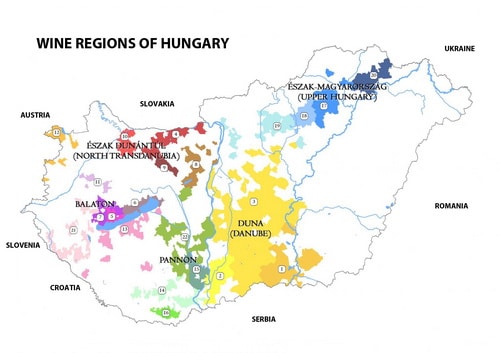About Hungary and its Wine Regions
Hungary is situated in the heart of Europe, in the lower central part of the Middle-Danube basin, surrounded by the eastern slopes of the Austrian Alps and the Carpathian mountains. It has frontiers with seven countries: Slovakia, Ukraine, Romania, Croatia in the south, Serbia, Slovenia and Austria in the west.
Territory: 93,036 m2, representing altogether 1% of the territory of Europe
Population: 10.2 million, representing altogether 2% of the population of Europe
Capital: Budapest
Language: Hungarian, which is very different from most of the languages spoken around the world
Hungary has been a member of the European Union since 2004.
The country is diversified by plains, hills and mountains. Basalt-vulcanite mountains are just as typical of the countryside, as chalk-stone or dolomite mountains, or flatlands filled up by rivers, saline- and sandy-soiled areas, fens and marshlands in river-flats. The red sandstone and Pannon sand of the ’Balatonfelvidék’ area, or the basalt tufa of the Tihany peninsula offer valuable and remarkable soils for wine-growing. Hungary has two large, and probably well-known rivers, River Danube and River Tisza.
There are several large natural and artificial lakes within the country, the largest one of which is Lake Balaton, which is the largest lake in Central Europe with an area of 591 km2. The so-called ’Balatonfelvidék’ is a typical Hungarian wine region at the same time.
Hungary is situated in the temperate zone, its climate is basically continental, the potential extremities of which are subdued by the Carpathian ranges, and the level of rainfall is just optimal. The region at the foot of the Alps (’Alpokalja’) is a special and remarkable part of the country. Its climate is subalpine, and the level of rainfall is well-balanced. In summary, this small country has all the climate- and soil-related potentials to grow excellent wine-grapes.
The characteristics of each wine region are determined by local soil conditions and micro-climate. Officially the country has twenty-two wine regions, however, these are grouped into larger macro-regions, such as Alföld, Balaton, southern slopes of Bükk mountain, Southern Transdanubia, Northern Transdanubia, Mátra and Tokaj. In the northern wine regions mostly white wines, while in the south-western and Southern Transdanubia region mainly red wines are produced.

